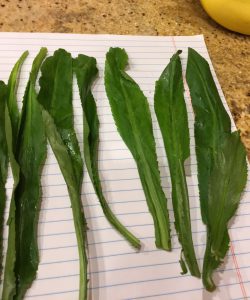 Culantro (Eryngium foetidum L.) is a biennial herb grown throughout the Caribbean and Central America, and is a key ingredient in Puerto Rican cooking. It is relatively unknown in the United States, and is often mistaken for its relative cilantro (Coriandrum sativum L.). It is also known by many other names, such as Puerto Rican coriander, Black Benny, saw leaf herb, Mexican coriander, Saw tooth coriander, long coriander, Spiny coriander, Fitweed, and spiritweed. In Puerto Rico it is known as recao.
Culantro (Eryngium foetidum L.) is a biennial herb grown throughout the Caribbean and Central America, and is a key ingredient in Puerto Rican cooking. It is relatively unknown in the United States, and is often mistaken for its relative cilantro (Coriandrum sativum L.). It is also known by many other names, such as Puerto Rican coriander, Black Benny, saw leaf herb, Mexican coriander, Saw tooth coriander, long coriander, Spiny coriander, Fitweed, and spiritweed. In Puerto Rico it is known as recao.
When cultivated, culantro thrives under well-watered, shady conditions. It belongs to the same plant family as cilantro, but looks quite different. The long, tough leaves smell very similar to cilantro (with much more flavor) thus making it a respectable summer substitute for cilantro, which prefers cooler weather.
Culantro can be planted in pots or on the ground. If planted in the ground, this herb will continue to reproduce for an almost endless supply. Culantro is relatively pest and disease free. It is rumored to be attractive to beneficial insects such as ladybugs, green lacewings, and to provide an excellent defense in the garden against aphids. In cooking it is used to flavor salsa, softrito, chutney, ceviche, sauces, rice, stews, and soups. To harvest , remove the oldest leaves all the way down to the base of the plant leaving the young new leaves to grow.The leaves can be chopped and used fresh or frozen to keep their flavor.
Photos by Rebecca Jordi
 1
1
